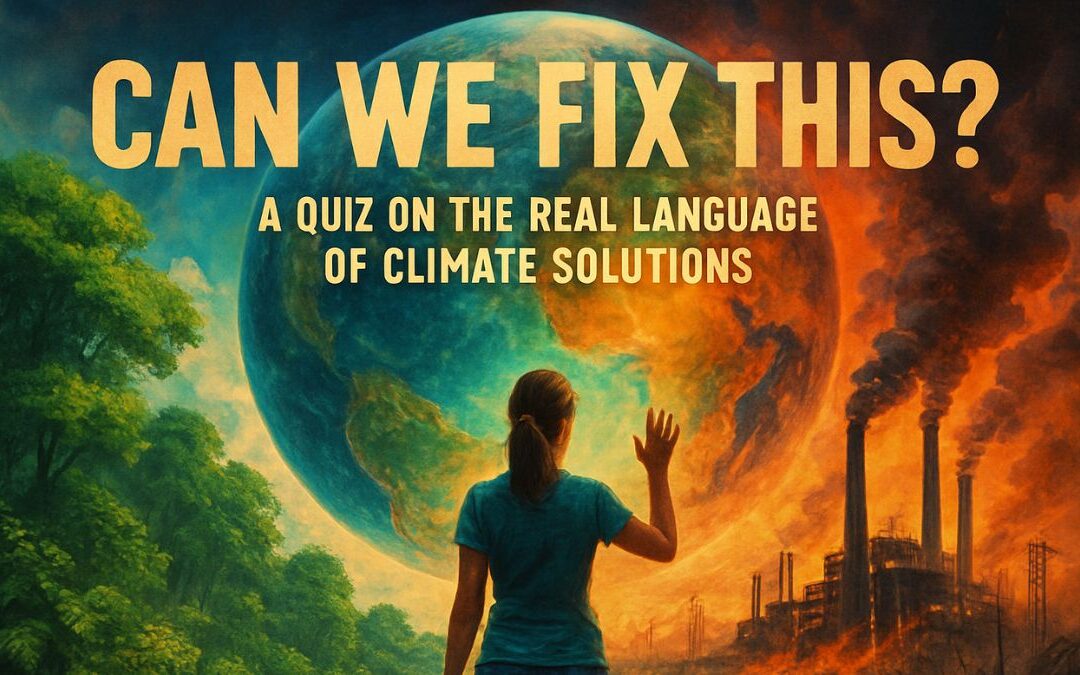- What Exactly is a Carbon Sink?
- The Magic of Photosynthesis: Nature’s Carbon Capture Technology
- How Trees Turn Air into Wood (and More)
- More Than Just Trees: The Forest Ecosystem as a Carbon Reservoir
- The Unseen Storage: Soil Carbon
- Litter and Deadwood
- The Global Scale: How Much Carbon Do Forests Hold?
- Threats to Our Green Guardians: When Sinks Become Sources
- Deforestation and Forest Degradation
- Climate Change: A Vicious Cycle
- Protecting and Enhancing Our Carbon Sinks: A Path Forward
- Reforestation and Afforestation
- Sustainable Forest Management
- The Future is Green (If We Choose It)
- Let’s Learn Vocabulary in Context
- Let’s Discuss
- Learn with AI
- Let’s Play & Learn
In the grand, intricate theatre of our planet’s systems, forests play a leading role, one that is becoming increasingly critical in the face of a changing climate. These sprawling emerald expanses are far more than just picturesque landscapes or sources of timber; they are Earth’s green lungs, breathing in carbon dioxide and, in return, gifting us with the oxygen we depend on. More than that, they are colossal natural reservoirs, or “carbon sinks,” diligently working to absorb and store atmospheric carbon, thereby mitigating the greenhouse effect. Understanding the profound importance of forests as carbon sinks is paramount as we navigate the complexities of global warming and strive for a sustainable future.
What Exactly is a Carbon Sink?
Before we delve into the verdant depths of forests, let’s clarify what we mean by a “carbon sink.” In essence, a carbon sink is any natural or artificial reservoir that accumulates and stores some carbon-containing chemical compound for an indefinite period. The process by which carbon sinks remove carbon dioxide (CO2) from the atmosphere is known as carbon sequestration. Our planet has several natural carbon sinks, with the most significant being the oceans, soils, and, our focus here, forests.
The concept is akin to a giant planetary sponge. As human activities, primarily the burning of fossil fuels and deforestation, release vast quantities of CO2 into the atmosphere, these sinks absorb a portion of it, preventing an even more rapid buildup of greenhouse gases and the associated warming.
The Magic of Photosynthesis: Nature’s Carbon Capture Technology
The primary mechanism by which forests act as carbon sinks is the elegant, age-old process of photosynthesis. It’s a biochemical marvel that plants, algae, and some bacteria have perfected over billions of years.
How Trees Turn Air into Wood (and More)
In the simplest terms, during photosynthesis, trees and other green plants use sunlight as energy to convert carbon dioxide from the atmosphere and water from the soil into glucose (a sugar, which is their food) and oxygen. This can be summarized by the chemical equation:
6CO2 (carbon dioxide)+6H2O (water)+Sunlight→C6H12O6 (glucose)+6O2 (oxygen)
The crucial part for carbon sequestration is what happens to that carbon, now locked into the glucose molecule. This glucose is used by the tree for several purposes:
- Growth: It’s the building block for cellulose, lignin, and other organic compounds that make up the tree’s wood, bark, leaves, and roots. This is where long-term carbon storage occurs. A towering ancient tree is, in effect, a magnificent column of stored atmospheric carbon.
- Energy: Trees respire, just like animals, using some of the glucose for energy and releasing a smaller amount of CO2 back into the atmosphere. However, a healthy, growing forest absorbs far more CO2 through photosynthesis than it releases through respiration.
- Reproduction and Maintenance: Producing seeds, repairing damage, and other life processes also require this energy.
The net effect in a thriving forest is a continuous drawdown of atmospheric CO2, with the carbon being incorporated into the forest’s biomass – the total mass of organisms in a given area or volume.
More Than Just Trees: The Forest Ecosystem as a Carbon Reservoir
While individual trees are the primary photosynthetic engines, the entire forest ecosystem contributes to its function as a carbon sink.
The Unseen Storage: Soil Carbon
A significant, and often underestimated, portion of a forest’s carbon is stored not in the towering trunks and branches, but in the soil. When leaves, needles, branches, and even entire trees die and decompose, the carbon they contain is incorporated into the forest floor as organic matter. This organic matter, rich in carbon, can remain stable in the soil for decades, centuries, or even millennia, especially in cooler climates where decomposition is slow. The complex web of fungi, bacteria, and invertebrates in forest soils plays a vital role in this carbon cycling and storage. This terrestrial carbon pool is a colossal hidden treasure.
Litter and Deadwood
The layer of fallen leaves, twigs, and other organic debris on the forest floor (known as litter) and standing or fallen deadwood also represent important carbon stores. While they will eventually decompose, this process can take many years, keeping the carbon locked away during that time.
The Global Scale: How Much Carbon Do Forests Hold?
The sheer scale of carbon sequestration by forests is astounding. Globally, forests are estimated to absorb roughly 2.6 billion tonnes of carbon dioxide each year, which is about a third of the CO2 released from the burning of fossil fuels. They store vast quantities of carbon: recent estimates suggest that the world’s forests store around 861 gigatonnes of carbon in their living biomass, deadwood, and soil combined. To put that into perspective, that’s more carbon than is currently present in the entire Earth’s atmosphere!
Different types of forests play varying roles:
- Tropical Forests: These lush, biodiverse powerhouses, like the Amazon rainforest, are particularly efficient at absorbing carbon due to their rapid growth rates and year-round photosynthesis. They are the planet’s largest forested carbon sink.
- Temperate Forests: Found in mid-latitudes, these forests (including deciduous and coniferous types) are also significant carbon stores, particularly in their soils.
- Boreal Forests (Taiga): These vast northern forests, stretching across Alaska, Canada, Scandinavia, and Russia, are characterized by coniferous trees. While their growth rates are slower due to colder climates, they store immense amounts of carbon in their soils and peatlands, accumulated over thousands of years.
Threats to Our Green Guardians: When Sinks Become Sources
Despite their crucial role, forests are under immense pressure worldwide. When forests are degraded or destroyed, they not only lose their ability to absorb CO2 but can also become significant sources of carbon emissions.
Deforestation and Forest Degradation
The most direct threat is deforestation – the clearing of forests for agriculture (e.g., cattle ranching, soy and palm oil plantations), logging, mining, and urban expansion. When trees are cut down and burned or left to decay, the carbon they stored is released back into the atmosphere as CO2. Forest degradation, which involves changes that negatively affect the structure or function of a forest (like selective logging or a high incidence of fires), also diminishes its capacity as a carbon sink. Globally, deforestation and forest degradation contribute a substantial percentage of global greenhouse gas emissions, estimated to be around 10-12%.
Climate Change: A Vicious Cycle
Climate change itself poses a significant threat to forests, creating a dangerous feedback loop:
- Increased Wildfires: Warmer temperatures and prolonged droughts make forests more susceptible to larger and more intense wildfires. These fires release massive amounts of stored carbon into the atmosphere in a short period.
- Pest Infestations and Diseases: Changing climatic conditions can alter the range and virulence of forest pests and diseases, leading to widespread tree mortality. The mountain pine beetle epidemic in North America is a stark example.
- Shifting Climate Zones: As temperatures rise, the optimal climate zones for certain tree species may shift. If forests cannot adapt or migrate quickly enough, they can decline, reducing their carbon uptake.
In some extreme cases, such as prolonged drought or repeated severe fires, a forest ecosystem can flip from being a net carbon sink to a net carbon source, exacerbating the very problem it was helping to mitigate.
Protecting and Enhancing Our Carbon Sinks: A Path Forward
The critical role of forests as carbon sinks underscores the urgent need for their conservation, sustainable management, and restoration. These actions are often referred to as “natural climate solutions.”
Conservation: Keeping Existing Forests Standing
Protecting existing forests, particularly primary (old-growth) forests that are rich in carbon and biodiversity, is paramount. This involves:
- Combating illegal logging and unsustainable forestry practices.
- Establishing and effectively managing protected areas.
- Empowering indigenous communities and local populations who are often the frontline guardians of forests.
- Addressing the economic drivers of deforestation by promoting sustainable land-use practices.
Reforestation and Afforestation
- Reforestation involves replanting trees in areas where forests have been cleared.
- Afforestation is the process of planting trees in areas where there was no previous tree cover.
Both strategies can help to create new carbon sinks and restore degraded landscapes. However, it’s crucial that these efforts prioritize planting native species and creating diverse, resilient ecosystems rather than monoculture plantations, which may be less effective as long-term carbon stores and offer fewer biodiversity benefits.
Sustainable Forest Management
This involves managing forests in a way that maintains their ecological integrity, biodiversity, and capacity to sequester carbon while allowing for the sustainable harvesting of forest products. Practices like reduced-impact logging, longer rotation periods, and protecting soil carbon are key components.
The Future is Green (If We Choose It)
Forests are not just a passive backdrop to human civilization; they are active, indispensable partners in maintaining a habitable planet. Their role as Earth’s primary terrestrial carbon sinks is a natural service of incalculable value. While they are not a silver bullet solution to climate change – a drastic reduction in fossil fuel emissions remains the linchpin of any effective climate strategy – protecting and restoring forests is an essential, powerful, and cost-effective way to help stabilize our climate.
The fate of these magnificent ecosystems, and by extension, a significant part of our planet’s climate regulation system, rests in our hands. By recognizing their worth, understanding the threats they face, and committing to their stewardship, we can ensure that forests continue to breathe life into our planet and absorb the carbon that threatens our future, for generations to come. It’s a colossal task, but one that is fundamental to the health of Planet Earth.
Let’s Learn Vocabulary in Context
Now that we’ve explored the vital role of forests as carbon sinks, let’s zoom in on some of the interesting words and phrases used in the article. Understanding these terms will not only deepen your comprehension of this topic but also enrich your general English vocabulary, making your conversations and writing more precise and engaging.
First up, we mentioned photosynthesis. While it’s a scientific term, it’s so fundamental to life on Earth that it’s worth understanding well. Photosynthesis is the process used by plants, algae, and certain bacteria to convert light energy into chemical energy, through a process that takes in carbon dioxide and water and releases oxygen. Think of it as the plant’s way of making its own food. The “photo” part refers to light, and “synthesis” means to make or put together. So, plants are literally “making things with light.” You could explain to a child, “Plants perform photosynthesis to grow, and that’s how they give us air to breathe!”
We talked about carbon being incorporated into the forest’s biomass. Biomass refers to the total quantity or weight of organisms in a given area or volume. It’s essentially all the living (or recently living) organic material – trees, shrubs, grasses, animals, microbes, etc. When we talk about forest biomass, we’re mostly referring to the trees themselves – their trunks, branches, leaves, and roots. It’s a key concept in ecology because it represents stored energy and, in our context, stored carbon. You might hear scientists discussing “calculating the biomass of a particular ecosystem to understand its productivity.”
The article referred to soil as a terrestrial carbon pool. Terrestrial is an adjective that simply means relating to the Earth or to land; worldly. It’s often used to distinguish things found on land from those found in water (aquatic) or in the air (aerial). So, a terrestrial ecosystem is a land-based one, like a forest or a grassland. “Lions are terrestrial predators, while sharks are aquatic.” It’s a useful word to differentiate environments.
We mentioned that deforestation contributes a substantial percentage of global greenhouse gas emissions. Substantial means of considerable importance, size, or worth. It suggests something large, significant, or solid. If an impact is substantial, it’s not minor or trivial; it really matters. For example, “She made a substantial donation to the charity,” or “There has been a substantial increase in a student’s performance after attending the extra classes.”
The article warned that a forest ecosystem can flip from being a net carbon sink to a net carbon source, exacerbating the problem. To exacerbate means to make (a problem, bad situation, or negative feeling) worse. It’s like pouring fuel on a fire. If climate change leads to more forest fires, these fires release carbon, which further worsens climate change – that’s exacerbating the problem. You could say, “His angry comments only served to exacerbate the tension in the room.”
When discussing solutions, reducing fossil fuel emissions was called the linchpin of any effective climate strategy. A linchpin (or lynchpin) is a person or thing vital to an enterprise or organization. Originally, it’s a pin passed through the end of an axle to keep a wheel in position. Metaphorically, it’s something that holds everything together or on which everything depends. If the linchpin is removed, the whole structure can fall apart. “Effective communication is the linchpin of a successful team.”
We referred to the task of protecting forests as colossal. Colossal means extremely large or great; immense. It comes from “Colossus,” like the Colossus of Rhodes, which was a giant statue. So, if a task is colossal, it’s huge, daunting, and requires enormous effort. “Building the pyramids was a colossal undertaking.”
The article stated that understanding the role of forests is paramount. If something is paramount, it is more important than anything else; supreme. It signifies the utmost importance. “In any emergency situation, the safety of the children is paramount.” It’s a strong word to emphasize priority.
We talked about the verdant depths of forests. Verdant means green with grass or other rich vegetation. It paints a picture of lush, healthy greenery. “The valley was verdant and beautiful after the spring rains.” It’s a lovely descriptive word often associated with nature.
Finally, we mentioned that deforestation is driven by various factors, including urban expansion. Expansion is the action of becoming larger or more extensive. It can refer to the growth of a business, a city, an idea, or anything that increases in size, scope, or volume. “The company is planning a major expansion into European markets.”
Using these words can certainly add a layer of sophistication and clarity to your discussions, especially when talking about complex topics like environmental science or policy. Practice weaving them into your vocabulary, and you’ll find your expressive abilities expanding!
Vocabulary Quiz
Let’s Discuss
Here are five discussion questions to delve deeper into the topic of forests as Earth’s carbon sinks:
- Beyond Carbon Sequestration: While their role as carbon sinks is vital, what are some other crucial ecological services that forests provide, and how do these services interconnect with their ability to store carbon?
- Consider biodiversity conservation (more species can mean more resilient ecosystems and potentially more efficient carbon capture), regulation of water cycles (healthy forests influence rainfall and prevent soil erosion, which protects soil carbon), air and water purification, and providing livelihoods for communities. How does a decline in one service impact others?
- The Deforestation Dilemma: The article mentions agriculture, logging, and mining as drivers of deforestation. What are the complex socio-economic factors that contribute to these activities, especially in developing nations where many large forests are located? How can global demand for certain products (like palm oil, beef, soy) in wealthier nations be reconciled with forest conservation?
- Explore poverty, lack of alternative livelihoods, governance issues, land rights, international trade policies, and consumer responsibility. Can economic development and forest protection go hand-in-hand? What role can sustainable certifications and ethical consumerism play?
- Reforestation vs. Protecting Old-Growth Forests: There’s often debate about the best strategies: should the focus be on planting new trees (reforestation/afforestation) or on protecting existing mature forests (especially old-growth)? What are the pros and cons of each approach in terms of carbon sequestration, biodiversity, and cost-effectiveness?
- Consider the time it takes for new forests to sequester significant carbon versus the immediate carbon loss from cutting old-growth. Discuss the unique ecological value of mature forests, the concept of “avoided emissions,” and the potential for both strategies to be part of a larger solution. Are there situations where one is clearly more beneficial than the other?
- The Role of Individual Action vs. Systemic Change: What meaningful actions can individuals take to help protect and enhance forest carbon sinks? How do these individual efforts compare in impact to the need for systemic changes in policy, industry practices, and international agreements?
- Think about consumer choices (sustainable products, reduced meat consumption), supporting conservation organizations, advocating for policy changes, reducing personal carbon footprints, and local tree-planting initiatives. How can individuals effectively push for larger systemic changes? Is one more important than the other, or are both essential?
- Climate Change Feedback Loops: The article mentions that climate change can turn forests from carbon sinks into carbon sources (e.g., through increased fires or pest outbreaks). How concerned should we be about these potential feedback loops? What are the implications if major forest biomes, like the Amazon or boreal forests, reach a tipping point and become net emitters of carbon?
- Explore the potential for runaway climate change if these feedback loops accelerate. Discuss the urgency of global emissions reductions to prevent these tipping points. What kind of research is needed to better understand and predict these risks? How can forest management strategies be adapted to build resilience against these climate impacts?
Learn with AI
Disclaimer:
Because we believe in the importance of using AI and all other technological advances in our learning journey, we have decided to add a section called Learn with AI to add yet another perspective to our learning and see if we can learn a thing or two from AI. We mainly use Open AI, but sometimes we try other models as well. We asked AI to read what we said so far about this topic and tell us, as an expert, about other things or perspectives we might have missed and this is what we got in response.
Hello there! It’s great to see such a thorough exploration of forests as carbon sinks. It’s a topic close to my digital heart, so to speak. While the article did an excellent job covering the main points, there are always a few more nuanced layers or emerging perspectives we can touch upon.
One aspect that’s gaining more attention is the critical role of biodiversity within forests for maximizing and stabilizing carbon sequestration. It’s not just about the number of trees, but also the variety of species and the complexity of the ecosystem. Diverse forests tend to be more resilient to threats like pests, diseases, and even some climate impacts. Different species may also utilize resources in complementary ways, potentially leading to more efficient overall carbon capture and storage in biomass and soil. So, when we talk about reforestation, planting diverse native species is far superior to monoculture plantations, not just for wildlife, but for long-term carbon benefits too.
Another crucial point, briefly mentioned, is the immense importance of soil carbon. For a long time, the focus was heavily on the carbon stored in the above-ground biomass (the trees themselves). However, forest soils, particularly in temperate and boreal regions, can hold several times more carbon than the trees standing on them. This soil organic carbon is a complex mix of decomposing plant matter, microbial biomass, and compounds that can remain stable for centuries. Disturbances like intensive logging or land conversion that disrupt the soil can release huge amounts of this stored carbon. Protecting soil integrity is therefore just as important as protecting the trees.
We should also consider the differing roles of old-growth forests versus young, actively growing forests. Young, regenerating forests can sequester carbon at a very high rate as the trees grow rapidly. However, old-growth forests, with their large trees, complex structures, and deep organic soils, store enormous amounts of carbon accumulated over centuries. While their net uptake rate might slow as they reach maturity (though recent research suggests many continue to sequester carbon), the sheer volume of carbon they already hold makes their protection absolutely critical. Losing an old-growth forest results in a massive carbon release that would take centuries for a new forest to recapture.
The impact of “cryptic” or indirect deforestation is also something to consider. This isn’t just about clear-cutting. It can involve things like the gradual degradation of forest edges, the impact of roads fragmenting forest landscapes (which can dry out interiors and increase fire risk), or the loss of key animal species that play roles in seed dispersal and forest regeneration. These subtle changes can reduce a forest’s overall health and its capacity as a carbon sink over time.
Finally, there’s the exciting and rapidly evolving field of monitoring forest carbon. Using satellite imagery, LiDAR technology, AI-driven data analysis, and on-the-ground measurements, scientists are getting much better at quantifying how much carbon forests are storing and how these stocks are changing. This is vital for verifying the effectiveness of conservation and reforestation projects, and for international agreements like the Paris Agreement, which relies on countries accurately reporting their emissions and carbon removals.
So, while the core message – protect and restore forests – is clear, the science behind it is continually advancing, revealing even more intricate details about how these vital ecosystems function and how we can best support them. It’s a dynamic field, and there’s always more to learn!










0 Comments